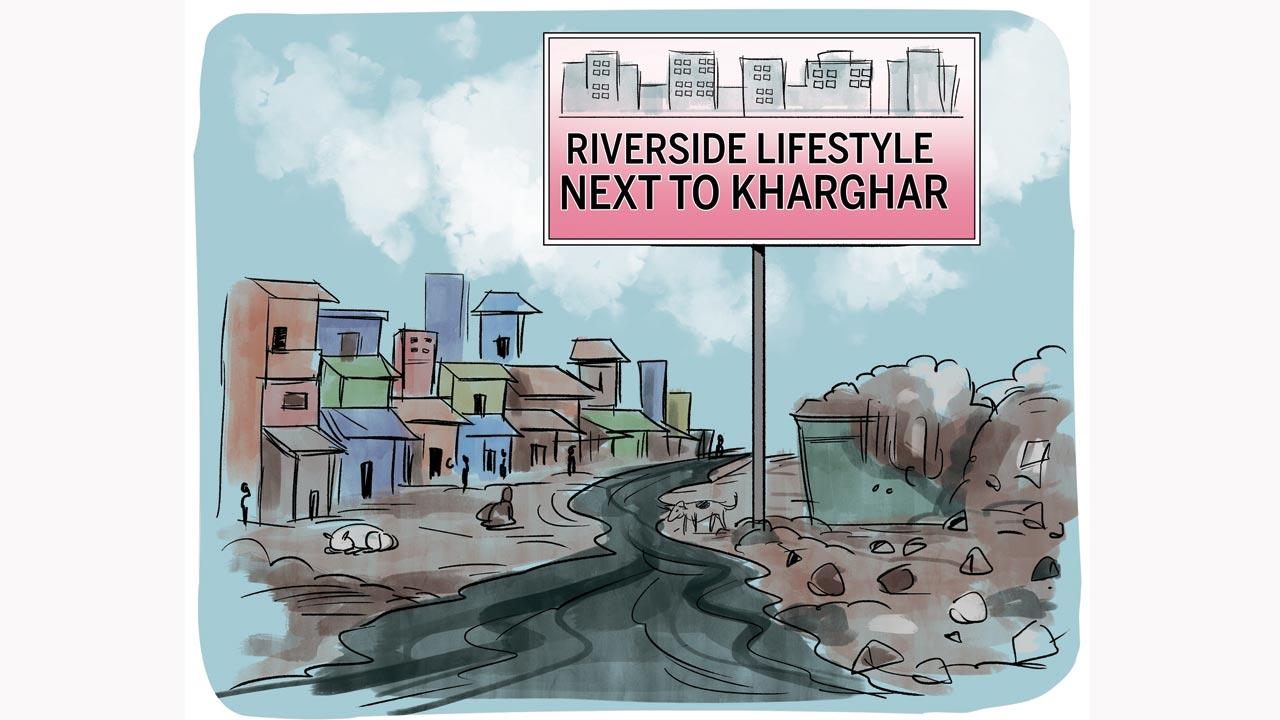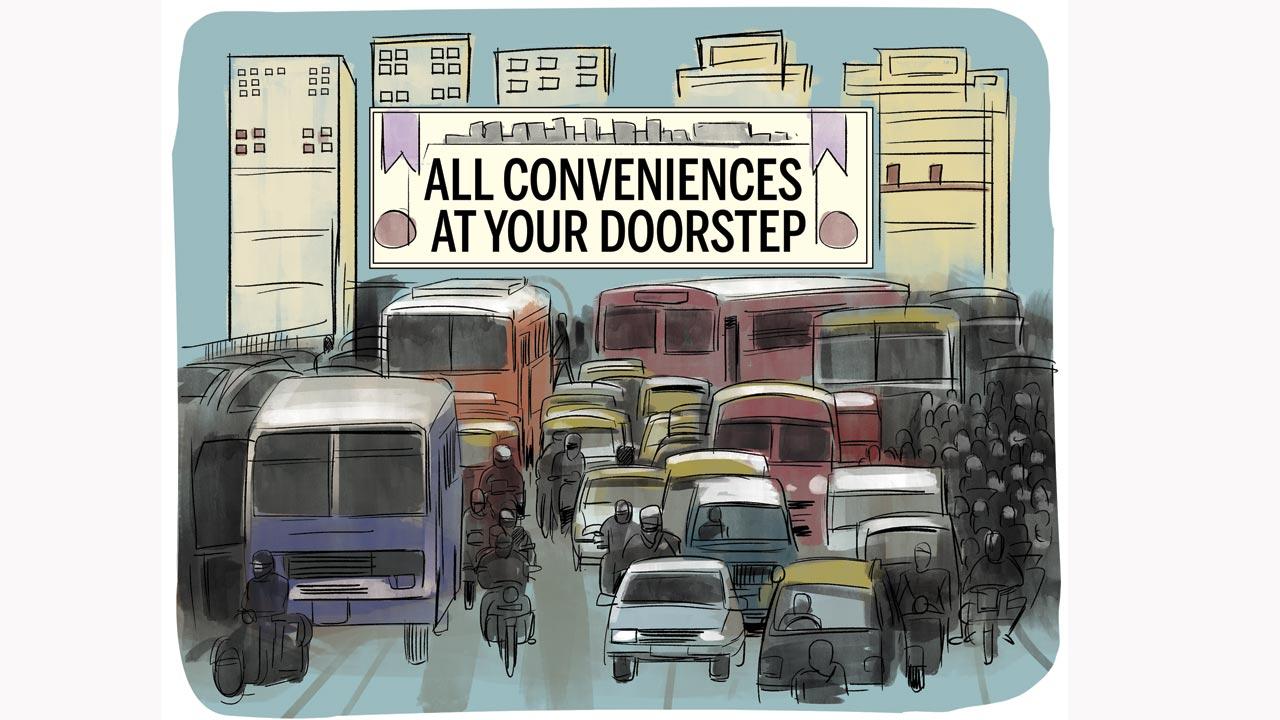Real estate billboard literature eloquently speaks of a vertically evolving ‘alternative’ Mumbai, many floors above the ground reality of air pollution and traffic

Illustrations/Uday Mohite
![]() In January 2015, I was besotted by an ad in which Dream Girl Hema Malini promised a Bollywood lifestyle in a housing project called ‘Wollywood’. The exotic, jazzed up Wollywood flats—which fall on the road to my in-laws’ home in the Wada village—offered something special. It wasn’t just the promise of a luxurious integrated township—that’s what most upcoming distant suburban projects are about anyway. There was the distinct audacity of hope in the Wollywood realty.
In January 2015, I was besotted by an ad in which Dream Girl Hema Malini promised a Bollywood lifestyle in a housing project called ‘Wollywood’. The exotic, jazzed up Wollywood flats—which fall on the road to my in-laws’ home in the Wada village—offered something special. It wasn’t just the promise of a luxurious integrated township—that’s what most upcoming distant suburban projects are about anyway. There was the distinct audacity of hope in the Wollywood realty.
ADVERTISEMENT
Hema Malini, the ambassador of this Gaates Budruk project, was offering the average Mumbaikar a chance to live like a Bollywood star in Palghar’s Wada taluka. This dream was being sold either as a second home for the city resident, or a new home for anyone living in the surrounding villages. The fantasy—conjured up for company brochures—was directly disproportionate to the realities of a taluka characterised by power cuts, water shortages, potholed roads, and, most importantly, the lack of medical support infrastructure. There was no room in the given context for the Wollywood aesthetic or any other style!

With every passing year, I continue to be affected by these tall claims of global urban living standards and grand billboards advertising green boulevards. In fact, real estate billboard literature has become the high point of my drives through the city and its suburbs, be it the “elite” Navi Mumbai resale flats, the forest town in Kolshet, the “empire” lifestyle apartments in Bhiwandi, the crown jewel of BKC, or the proposition of a midtown bay near my own Mahim home. Incidentally, Wollywood now has many contenders in the form of “nirvana” bungalows in Wada and Vikramgadh.
I have followed the rare occasions when the hard sell of these projects has been countered. For instance, one builder was admonished by the Maharashtra Real Estate Regulatory Authority for claiming to build India’s tallest building in south Mumbai. The MahaRERA issued show cause notices to the builder for the 90-storey building he did not ultimately build. Another was pulled up by the Bombay High Court for projecting a false, misleading glossy green picture in the project brochure, which was not in consonance with the real-life result.

But these instances in no way impede realty firms from continuing to make hyperbolic claims. In fact, as the year ends, Mumbai flashes one too many billboards with catchy lines on attractive features, encouraging buyers to “leave the city at the gates” and enter an idyllic, comforting world.
Nomenclature is the name of the game in this world of sylvan homes. Major real estate companies select foreign-sounding titles for their projects. One company even added a French accent to its own brand name—calling itself a Groupé—for which it was ridiculed on social media. But names wield an undeniable influence on the home buyer. How could you not pay attention to the “elegante” complex in Andheri which offers flats with a swimming pool and gymnasium; the under-construction “emerald island” in Powai which has eight towers on a prime patch of seven acres of land; the crescent-shaped property in Parel which aspires to be (in letter, not spirit) its namesake in northern New Zealand. Indeed, the best way to “modernise” the interiors of the city is to rename its buildings suitably. Aren’t these fancy, rechristened neighbourhoods better addresses than a Pinto Mansion, or a Lalit Sahanivas, or a Rose Minar?

Much like the vast potential of names, there is a tremendous power in the ad copy that accompanies them. At a time when Mumbai’s air quality, traffic congestion and noise pollution are depressants for the newspaper reader, the billboards divert her attention to lush meadows, spacious club houses, children’s parks and vast walking tracks. They reassure her with the image of a vertically growing ‘alternative’ Mumbai—a city of possibilities, sparkling clean with no slums or squalor—a builders’ paradise in which the sky is literally the limit.
At one point, the Maharashtra government proposed a bill which included a jail term for builders who made rosy, unrealistic promises. The bill was not passed, and the realty sector naturally continued with its billboards. Rarely do buyers seek recourse through any redressal mechanism, whether it is the Consumer Protection Act, or the Advertising Standards Council of India. Nowadays, builders are compelled by the MahaRERA to publicise their approved plans online. However, that provision has not induced much transparency in the process.
For this columnist, it is the classic tale of residing in two contrasting cities—the first is the real Mumbai, in which I patiently wait in the evening for an Uber taxi to take me home through the traffic bottlenecks of BKC. The second is the redefined, manicured Mumbai on billboards, where groceries can arrive at my doorstep, and my family can leisurely play a sport together at the end of a weekday.
Sumedha Raikar-Mhatre is a culture columnist in search of the sub-text. You can reach her at sumedha.raikar@mid-day.com
 Subscribe today by clicking the link and stay updated with the latest news!" Click here!
Subscribe today by clicking the link and stay updated with the latest news!" Click here!







